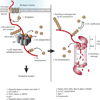Protein quality control in the ER: balancing the ubiquitin checkbook
- PMID: 22055166
- PMCID: PMC3564647
- DOI: 10.1016/j.tcb.2011.09.010
Protein quality control in the ER: balancing the ubiquitin checkbook
Abstract
Protein maturation in the endoplasmic reticulum (ER) is subject to stringent quality control. Terminally misfolded polypeptides are usually ejected into the cytoplasm and targeted for destruction by the proteasome. Ubiquitin conjugation is essential for both extraction and proteolysis. We discuss the role of the ubiquitin conjugation machinery in this pathway and focus on the role of ubiquitin ligase complexes as gatekeepers for membrane passage. We then examine the type of ubiquitin modification applied to the misfolded ER protein and the role of de-ubiquitylating enzymes in the extraction of proteins from the ER.
Copyright © 2011 Elsevier Ltd. All rights reserved.
Figures


References
-
- Braakman I, Bulleid NJ. Protein folding and modification in the Mammalian endoplasmic reticulum. Annu Rev Biochem. 2011;80:71–99. - PubMed
-
- Ward CL, Kopito RR. Intracellular turnover of cystic fibrosis transmembrane conductance regulator. Inefficient processing and rapid degradation of wild-type and mutant proteins. J Biol Chem. 1994;269:25710–25718. - PubMed
-
- Ron D, Walter P. Signal integration in the endoplasmic reticulum unfolded protein response. Nat Rev Mol Cell Biol. 2007;8:519–529. - PubMed
-
- Rapoport TA. Protein translocation across the eukaryotic endoplasmic reticulum and bacterial plasma membranes. Nature. 2007;450:663–669. - PubMed
Publication types
MeSH terms
Substances
Grants and funding
LinkOut - more resources
Full Text Sources
Other Literature Sources

